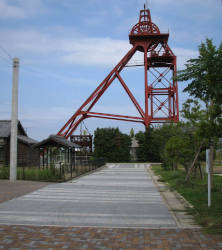田川市石炭・歴史博物館
Tagawa City Coal and History Museum
Useful Information

| Location: |
〒825-0002 Fukuoka, Tagawa, Ita, 2734-1.
(33.640830, 130.813890) |
| Open: |
04-JAN to 28-DEC Tue-Sun, Hol 9:30-17:30, last entry 17. Closed on Tuesday if Monday is a Holiday. [2022] |
| Fee: |
Adults JPY 400, Children (12-17) JPY 100, Children (6-11) JPY 50, Seniors (65+) JPY 280. Disabled: Adults JPY 100, Children (12-17) JPY 50, Children (6-11) JPY 30. Groups (20+): Adults JPY 280, Children (12-17) JPY 70, Children (6-11) JPY 30. Free for School Pupils on Saturdays. [2022] |
| Classification: |
 Mining Museum Mining Museum
|
| Light: |
 Electric Light Electric Light
|
| Dimension: | |
| Guided tours: | self guided. |
| Photography: | |
| Accessibility: | |
| Bibliography: | |
| Address: |
田川市石炭・歴史博物館 (Tagawa City Coal and History Museum), 〒825-0002 Fukuoka, Tagawa, Ita, 2734-1, Tel: +81-947-44-5745.
E-mail: |
| As far as we know this information was accurate when it was published (see years in brackets), but may have changed since then. Please check rates and details directly with the companies in question if you need more recent info. |
|
History
| 1983 | 田川市石炭資料館 (Tagawa City Coal Museum) opened to the public. |
| 2005 | museum registered according to the Museum Act and renamed 田川市石炭・歴史博物館 (Tagawa City Coal and History Museum). |
| 2011 | listed on the UNESCO Memory of the World Heritage List. |
Geology
Description
The 田川市石炭・歴史博物館 (Tagawa City Coal and History Museum) is located on the former grounds of the largest colliery of the area, the 所伊田竪坑 (Tokoro-Ita Shaft or Ida Shaft). The colliery was operated by the 三井田川鉱業 (Mitsui Tagawa Mining Co.). It was the biggest colliery of the Chikuho area.
The museum was enlisted on the UNESCO Memory of the World Heritage List in 2011. If you are confused and thought this list was actually named UNESCO World Heritage List, you are wrong. There is a second list, and it is solely for documentation, which includes documents, books, pictures, drawings, photographs and so on. They listed the Sakubei Yamamoto Collection which includes paintings and diaries by the coal miner Sakubei Yamamoto. It tells about the events during the industrial revolution as seen from a miner. This is highly unusual, as in a Japan the dominant records of the period are official government and business papers.
About 15,000 items in the museum’s collection are related to coal. It also houses and displays nationally renowned archaeological and historical materials, such as one of the oldest horse-shaped haniwa clay wheels and armor-shaped haniwa clay wheels in Japan. There is a wide variety of Kofun-era weapons, armor, and harnesses excavated from the Sesudono Tumulus. And there is a collection of silla-style roof tiles excavated from the Tendaiji Site (Kamiida Haiji).
- See also
 Search DuckDuckGo for "Tagawa City Coal and History Museum"
Search DuckDuckGo for "Tagawa City Coal and History Museum" Google Earth Placemark
Google Earth Placemark 田川市石炭・歴史博物館, official website
田川市石炭・歴史博物館, official website  (visited: 26-FEB-2022)
(visited: 26-FEB-2022) 田川市石炭・歴史博物館
田川市石炭・歴史博物館  (visited: 28-FEB-2022)
(visited: 28-FEB-2022) Sakubei Yamamoto Collection (visited: 28-FEB-2022)
Sakubei Yamamoto Collection (visited: 28-FEB-2022) Sakubei Yamamoto Collection, official website (visited: 28-FEB-2022)
Sakubei Yamamoto Collection, official website (visited: 28-FEB-2022) Tagawa City Coal and History Museum (visited: 19-APR-2022)
Tagawa City Coal and History Museum (visited: 19-APR-2022) Tagawa City Coal Mining Historical Museum (visited: 19-APR-2022)
Tagawa City Coal Mining Historical Museum (visited: 19-APR-2022) Tagawa Coal Mining Museum (visited: 19-APR-2022)
Tagawa Coal Mining Museum (visited: 19-APR-2022)
 Index
Index Topics
Topics Hierarchical
Hierarchical Countries
Countries Maps
Maps